第五章水蒸气与湿空气
- 格式:ppt
- 大小:1.28 MB
- 文档页数:43
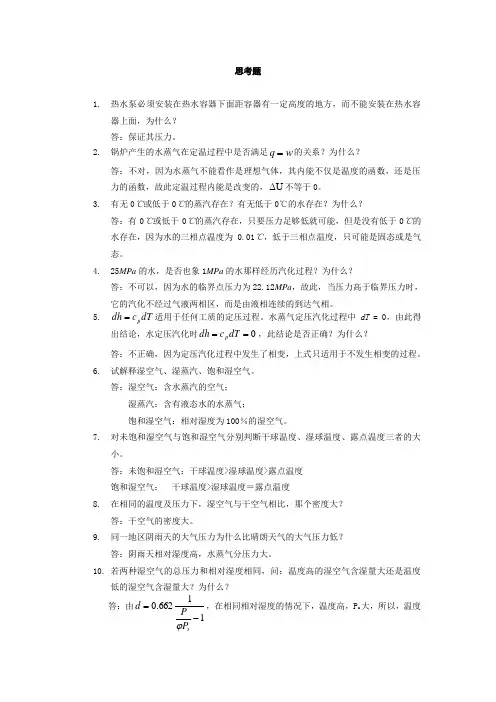
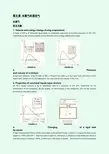
第五章 水蒸气和湿空气水蒸气 英文习题1. Volume and energy change during evaporationA mass of 200 g of saturated liquid water is completely vaporized at constant pressure of 100 kPa. Determine (a) the volume change and (b) the amount of energy added to the water.2.Pressureand volume of a mixtureA rigid tank contains 10 kg of water at 90℃. If 8 kg of the water is in the liquid form and rest is in thevapor form. Determine (a) the pressure in the tank and (b) the volume of the tank.3. Properties of saturated liquid-vapor mixtureAn 80-L vessel contains 4 kg of refrigerant-134a at a pressure of 160 kPa. Determine (a) the temperature of the refrigerant, (b) the quality, (c) the enthalpy of the refrigerant, and (d) the volume occupied by the vapor phase.4.Charging of a rigid tankby steamA rigid insulated tank that is initially evacuated is connected through a valve to a supply line that carries steam at 1 MPa and 300℃. Now the valve is opened, and steam is allowed to flow slowly into the tank until the pressure reaches 1 MPa, at which point the valve is closed.Determine the final temperatureFIGURE 5-1FIGURE 5-2FIGURE 5-3FIGURE 5-4of the steam in the tank.湿空气 英文习题1. The amount of water vapor in room air100 kPa A 5-m ×5-m×3-m room shown in Fig.5-1 contains air at 25℃ and at a relative humidity of 75 percent. Determine (a) the partial pressure of dry air, (b) the specific humidity, (c) the enthalpy per unit mass of the dry air,and (d) the masses of the dry air and water vapor in the room.2. Fogging of the windows in a houseIn cold weather, condensation frequently occurs on the inner surfaces of the windows due to the lower air temperatures near the window surface. Consider a house, shown in Fig.5-6, that contains air at 20℃ and 75 percent relative humidity. At what window temperature will themoisture in the air start condensing on the inner surfaces of thewindows?3. The specific and relative humidity of airThe dry and the wet-bulb temperatures of atmospheric air at 1 atm (101.325 kPa) pressure are measured with a sing psychrometer and determined to be 25℃ and 15℃, respectively. Determine (a0 the specific humidity, (b0 the relative humidity, and © the enthalpy of the air.4. Heating and humidification of airAn air-conditioning system is to take in outdoor air at 10℃ and 30 percent relative humidity at a steady rate of 45 m 3/min and to condition it to 25℃ and 60 percent relative humidity. The outdoor air is first then heated to 22℃ in the heating section and humidified by the injection of hot steam in the humidifying section. Assuming the entire process takes place at a pressure of 100 kPa, determine (a) the rate of heat supply in the heating section and (b) the mass flow rate of the steamrequired in the humidifying section.5. Cooling and dehumidification of airAir enters a window air conditioner at 1 atm, 30℃, and 80 percent relative humidity at rate of 10 m 2/min, and it leaves as saturated air at 14℃. Part of the moisture in the air that condenses during the process is also removed at 14℃. Determine the rates of heat and moisture removal from the air.工程热力学与传热学第五章 水蒸气与湿空气 习题FIGURE 5-5FIGURE 5-6FIGURE 5-7习题1.热水泵必须安装在热水容器下面距容器有一定高度的地方,而不能安装在热水容器的上面,为什么?2.锅炉产生的水蒸气在定温过程中是否满足q=w的关系?为什么?3.有无0℃或低于0℃的蒸汽存在?有无高于400℃的水存在,为什么?4.25MPa的水,是否也象1MPa的水那样经历汽化过程?为什么?5.dh=c p dT适用于任何工质的定压过程,水蒸气定压汽化过程中dT=0,由此得出结论,水定压汽化时dh=c p dT=0,此结论是否正确,为什么?6.试解释湿空气,湿蒸汽,饱和湿空气。
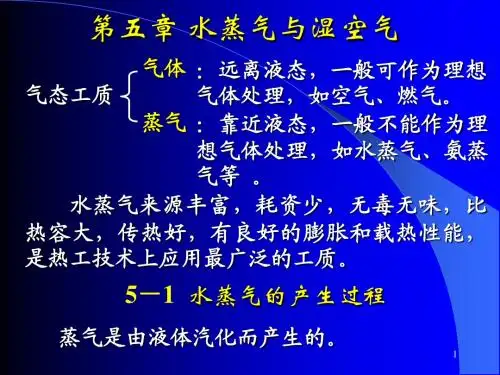
![(6)第五章水蒸汽热力性质_热工基础 [兼容模式].](https://uimg.taocdn.com/241e41e39ec3d5bbfd0a7444.webp)
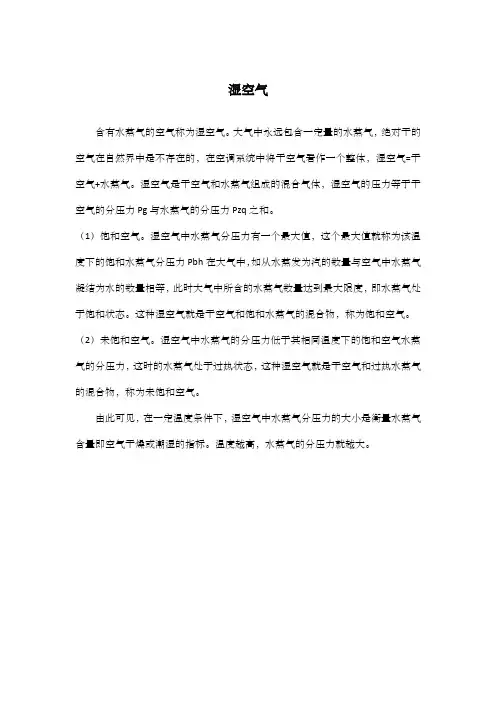
湿空气
含有水蒸气的空气称为湿空气。
大气中永远包含一定量的水蒸气,绝对干的空气在自然界中是不存在的,在空调系统中将干空气看作一个整体,湿空气=干空气+水蒸气。
湿空气是干空气和水蒸气组成的混合气体,湿空气的压力等于干空气的分压力Pg与水蒸气的分压力Pzq之和。
(1)饱和空气。
湿空气中水蒸气分压力有一个最大值,这个最大值就称为该温度下的饱和水蒸气分压力Pbh在大气中,如从水蒸发为汽的数量与空气中水蒸气凝结为水的数量相等,此时大气中所含的水蒸气数量达到最大限度,即水蒸气处于饱和状态。
这种湿空气就是干空气和饱和水蒸气的混合物,称为饱和空气。
(2)未饱和空气。
湿空气中水蒸气的分压力低于其相同温度下的饱和空气水蒸气的分压力,这时的水蒸气处于过热状态,这种湿空气就是干空气和过热水蒸气的混合物,称为未饱和空气。
由此可见,在一定温度条件下,湿空气中水蒸气分压力的大小是衡量水蒸气含量即空气干燥或潮湿的指标。
温度越高,水蒸气的分压力就越大。
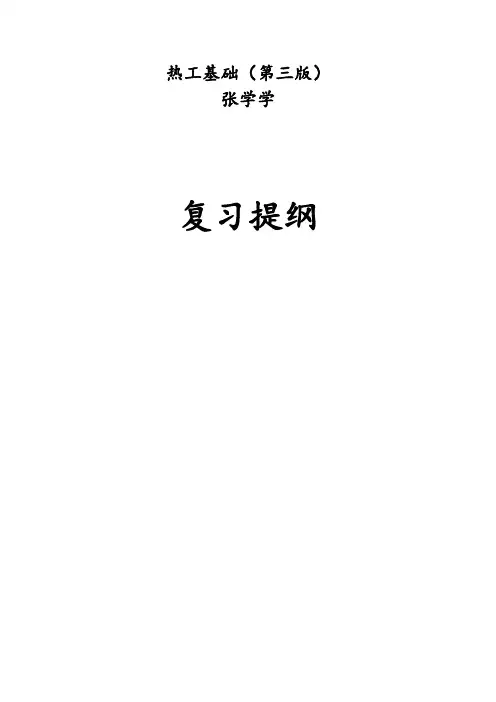
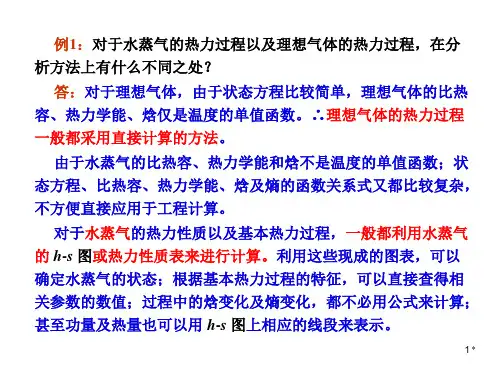
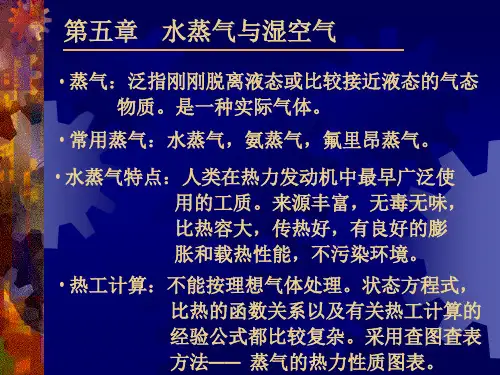

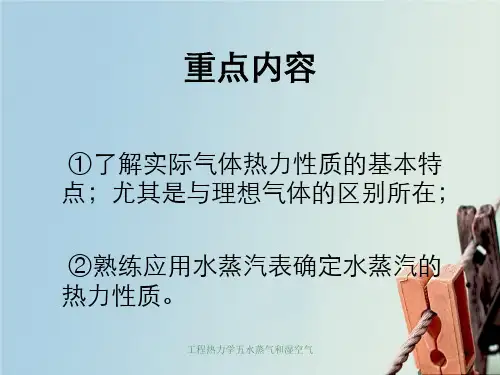
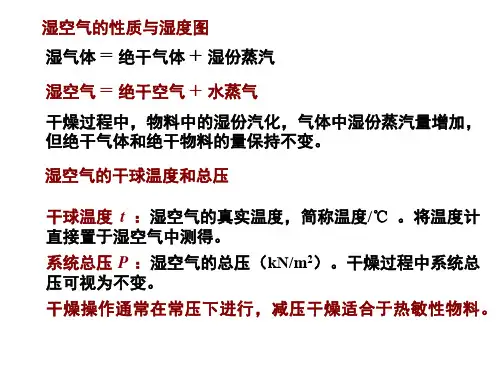
湿度和水蒸气分压的关系湿度是指空气中所含水蒸气的含量,是一个描述空气中水分含量多少的物理量。
水蒸气分压是指水蒸气在一定温度下对外施加的压力。
湿度和水蒸气分压之间存在着密切的关系,下面将详细介绍它们之间的联系。
湿度和水蒸气分压之间存在着直接的比例关系。
随着湿度的增加,空气中的水蒸气分压也会增加。
这是因为湿度是指单位体积空气中所含水蒸气的质量,而水蒸气分压则是水蒸气对外施加的压力。
当空气中的水蒸气含量增加时,水蒸气分子会与空气中的其他分子相互碰撞,从而使水蒸气分子对外施加的压力增加。
湿度和水蒸气分压之间也受到温度的影响。
温度越高,水蒸气分子的动能越大,相应地,水蒸气分压也会增加。
这是因为温度的升高会使水蒸气分子的平均动能增加,从而增加水蒸气分子与空气分子之间的碰撞频率和强度,进而增加水蒸气分子对外施加的压力。
湿度和水蒸气分压之间还受到空气的压强的影响。
当空气的压强增加时,空气分子的密度增加,水蒸气分子之间的碰撞频率也会增加,从而使水蒸气分子对外施加的压力增加。
因此,在相同温度下,湿度和水蒸气分压也会随着空气压强的增加而增加。
湿度和水蒸气分压之间存在着密切的关系。
湿度的增加会导致水蒸气分压的增加,而温度和空气压强的增加也会使水蒸气分压增加。
这种关系在气象学、环境科学、工程技术等领域都具有重要的意义。
对于人们的日常生活和生产活动,了解湿度和水蒸气分压的关系,有助于合理利用水资源、控制空气湿度、保持室内环境的舒适性等方面起到积极的作用。
湿度和水蒸气分压之间存在着直接的比例关系,而且受到温度和空气压强的影响。
深入理解和掌握湿度和水蒸气分压的关系,对于人们的生活和工作都具有重要的意义。
通过科学的研究和实践,人们可以更好地利用和控制湿度和水蒸气分压,为社会经济的可持续发展提供有益的支持。